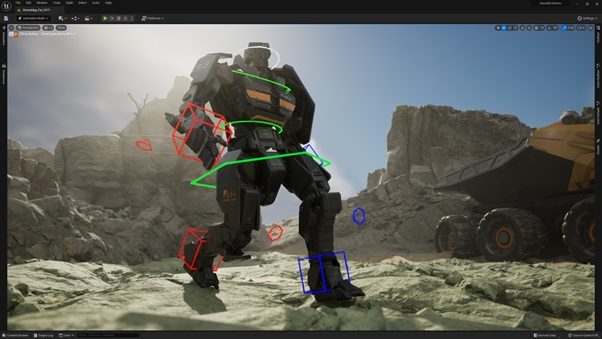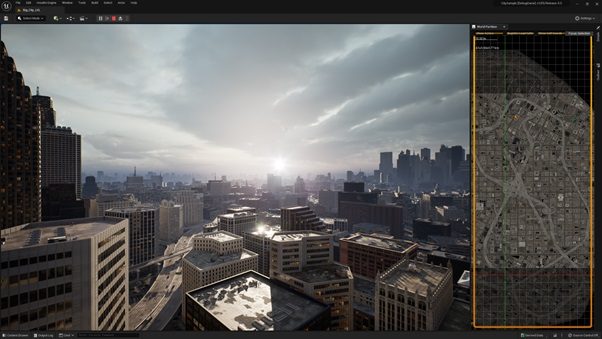Epic Games has lifted Unreal Engine 5 out of the beta and into official release just a couple of days ago.
Through this announcement, the 5th iteration of the popular game engine will itself overwrite Unreal Engine 4 as the latest official installment with tons of brand new tech to help fellow developers to create next-generation 3D assets, lighting, and contents with greater freedom, fidelity, and flexibility. So let’s go through some of the most groundbreaking ones that will be the basis for future hot-selling games.
Real-Time Rendering

Unreal Engine 5 will be using Lumen which is a fully dynamic global illumination solution where indirect lighting adapts to any changes when it meets another source of direct lighting or geometry so you don’t need to author lightmap UVs and wait for lightmaps to process or even place reflection captures. Simply create and edit lights inside the Unreal Editor and see the realistic lights being shine upon elements that are ever-changing.
Another cool thing is the virtualized micropolygon geometry system Nanite that gives artists to create massive geometric details with ease by directly importing film-quality sources from things like ZBrush sculpts to photogrammetry scans without taking a huge performance hit and fidelity. Aiding Lumen and Nanite is the Virtual Shadow Maps (VSM) providing soft shadows with justifiable performance costs and when both of them work together, they can intelligently stream and process details that can be perceived at one moment to cut down unnecessary poly count and draw call and with Temporal Super Resolution (TSR) doing the upsampling tasks, ultra fidelity gameplay at high frame rates is now and no more the future.
New Toolsets for World Building

As game consoles now use ultra-fast PCIe 4.0 drives and Windows 11 (and soon Windows 10) implements DirectStorage for practical loading times as low as 1 second, how game engine stream assets especially the larger ones will be a challenge. In Unreal Engine 5, the World Partition system divides the world into grids to stream only those that are in the vicinity of the player’s view while letting multiple devs work on the same region at once thanks to the One File Per Actor (OFPA) system and with Data Layers, realizing different versions of an environment and changing them dynamically will not require artists to remake most structures and geometry now. Just plop in the necessary unique layers and watch them change in real-time.
Built-in Character and Animation Tools
One of the aspects Unreal Engine 5 wants to speed up is character creation and animation where in games that rely on building cities and communities, those tasks can be daunting. But with Unreal Editor, most things can be copy-pasted such as rig creation via Control Rig, animating them in Sequencer, storing poses within the new Pose Browser, and applying blended keys with undershoot or overshoot via Tween. The powerful engine allows you to transfer animations between characters with different skeletons and proportions as well as between humans and animals. I think modders will be the happiest about this.
You can also adjust animations at runtime to compensate for different parameters such as height, speeds, terrains, and more thanks to Motion Warping adopting one set of animations to be used for things like vaulting over walls of different heights while Distance matching controls the play rate and Pose Warping to fine-tune poses to match the motion of the characters.
Enhanced In-editor modeling, UV editing, and baking
Aside from making the tasks of character-related assets easier, mesh creation is also one of the time-consuming things to create. But with the new tools, even the densest variants created from RealityCapture or by kitbashing Quixel Megascans can be tackled with the newly expanded suite of UV editing tools with the new UV Editor panel offering support for laying out, selecting, transforming, and cutting and sewing UVs in 2D space; viewing, copying, adding, and removing UV channels; automatic unwrapping; and previewing in 3D with a checker or custom texture. New baking tools that offer improvements in normal, AO, and vertex baking can be found too, and multi-sampling, texture filtering, UV layers, and N to 1 baking are also key features of the updated toolset.
Improved Editor UI and Workflow
Being the new engine for modern games, the Unreal Engine 5 also received a slight overhaul that brings it more into line with the digitalized world that makes use of every screen real estate to give an easier, faster, and pleasing user experience. For starters, Quixel Bridge is now fully integrated and all devs have to do is just drag and drop to gain access to the entire Megascans library you can find it in the new Create menu that hosts all sorts of content including Actors which also utilizes drag and drop mechanism and one-click access for scene population.
Content Browser also got a small yet important update in the form of hotkey designation and now being dockable to any collapsible sidebar. Details panel can be accessed with more properties displayed at a quicker rate and the Section bar displays groups of related properties.
Full On Procedural Audio Engine at Your Service
Unreal Engine 5’s improvement not only focuses on delivering visuals but also audios by the name of the new MetaSounds, a high-performance system that gives full control over audio DSP graph generation and the best thing about it is its analogous nature to be fully programmable and be part of the rendering pipeline via dynamic data-driven assets, mapping game parameters to sound playback and more.
Forget Ray Tracing, Get onto Path Tracing

First introduced in Unreal Engine 4.27, the Path Tracer has been buffed to meet UE5’s demands and has been given enhancements in stability, performance and more feature to provide more wholly-packed accessibility including support for hair primitives and the eye shader model, improvements in sampling, BRDF models, light transport, supported geometries, and more.
Truthfully, there’s more to explore in Unreal Engine 5 and it is also following the old rules: Any game that doesn’t exceed one million dollars in sale won’t be paying royalties to Epic Games so feel free to start downloading it and experience the real Unreal.



